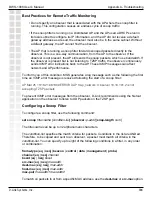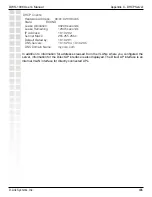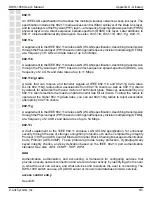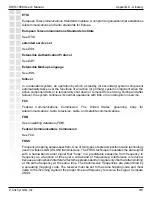
406
DWS-1008 User’s Manual
D-Link Systems, Inc.
Appendix C - DHCP Server
How the MSS DHCP Server Works
When MSS receives a DHCP Discover packet, the DHCP server allocates an address from
the configured range according to RFC 2131 and ARPs the address to ensure that it is not
already in use. If the address is in use, the server allocates the next address in the range,
and ARPs again. The process continues until MSS finds an address that is not in use. MSS
then offers the address to the Distributed AP or client that sent the DHCP Discover. If there
are no unused addresses left in the range, MSS ignores the DHCP Discover and generates
a log message.
If the client does not respond to the DHCP Offer from the MSS DHCP server within 2 minutes,
the offer becomes invalid and MSS returns the address to the pool.
The siaddr value in the DHCP exchanges is the IP address of the VLAN. The yiaddr value is
an unused address within the range the server is allowed to use.
In addition to an IP address, the Offer message from the MSS DHCP server also contains
the following options:
• Option 54 - Server Identifier, which has the same value as siaddr.
• Option 51 - Address Lease, which is 12 hours and cannot be configured.
• Option 1 - Subnet Mask of the VLAN’s IP interface.
• Option 15 - Domain Name, which is the default domain name configured on the
switch. If the default domain name is not configured, this option is blank.
• Option 3 - Router. If the IP route table contains a default route with an address
in the subnet configured on the VLAN, then the server specifies this address.
Otherwise, the server does not specify a router address.
• Option 6 - Domain Name Server, which is a list of the DNS server IP addresses
configured on the switch. If no DNS servers are configured on the switch, this
option is blank.
Configuring the DHCP Server
You can configure the DHCP server on an individual VLAN basis. To configure the server,
use the following command:
set
interface
vlan-id
ip
dhcp-server
[
enable
|
disable
] [
start
ip-addr1
stop
ip-addr2
]
The
vlan-id
can be the VLAN name or number.
The
start
ip-addr1
and
stop
ip-addr2
options specify the beginning and ending addresses of
the address range (also called the address
pool
). By default, all addresses except the host
address of the VLAN, the network broadcast address, and the subnet broadcast address are
included in the range. If you specify the range, the start address must be lower than the stop
address, and all addresses must be in the same subnet. The IP interface of the VLAN must
be within the same subnet but is not required to be within the range.
Summary of Contents for DWS-1008
Page 1: ......
















































